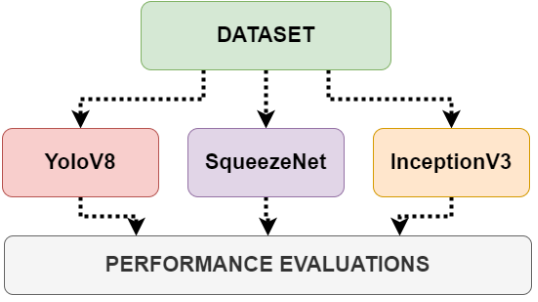Automatic Classification and Detection of Faulty Packaging using Deep Learning Algorithms: A Study for Industrial Applications
DOI:
https://doi.org/10.58190/imiens.2024.83Keywords:
classification, Deep Learning, faulty, industry, object detectionAbstract
In order to market the product to the consumer with the correct methods and to increase the reliability and sustainability of the brand in many stages from the production stage to the launch of the product in the national and international environment, to prevent faulty problems that may be encountered, the project will classify the packages with computer vision within the framework of deep learning algorithms and detect faulty packages. Studies have been carried out in this direction with the aim of saving labor and time, reducing the margin of error and increasing efficiency. In the study, a total of 3000 images, 1000 from each class, were used in three classes of fruit juice boxes called "Flawless", "Pressed" and "Stained" to ensure the image distribution ratio according to classes. In the study, training and testing of the model was carried out using the YoloV8 object detection algorithm. In addition, in order to make comparisons, SqueezeNet and IncepptionV3 classification models were trained and tested using images. Values of 99.5% for mAP50 and 97.9% for mAP50-95 were obtained from the YoloV8 model. 100% classification success was achieved from the SqueezeNet model and 99.9% classification success was achieved from the InceptionV3 model. The performance results obtained from the tests of the models were analyzed and evaluated, and then real-time testing was carried out. The accuracy of the study was evaluated by taking real-time images of the juice boxes moving on the conveyor with a camera. It is thought that the system created as a result of the study can be used in the industrial field.
Downloads
References
Song, K. and Y. Yan, A noise robust method based on completed local binary patterns for hot-rolled steel strip surface defects. Applied Surface Science, 2013. 285: p. 858-864.
Bulnes, F.G., et al., An efficient method for defect detection during the manufacturing of web materials. Journal of Intelligent Manufacturing, 2016. 27: p. 431-445.
Zhang, H., L. Jiang, and C. Li, CS-ResNet: Cost-sensitive residual convolutional neural network for PCB cosmetic defect detection. Expert Systems with Applications, 2021. 185: p. 115673.
Gubbi, J., et al., Internet of Things (IoT): A vision, architectural elements, and future directions. Future generation computer systems, 2013. 29(7): p. 1645-1660.
Biji, K., et al., Smart packaging systems for food applications: a review. Journal of food science and technology, 2015. 52: p. 6125-6135.
Adley, C.C., Past, present and future of sensors in food production. Foods, 2014. 3(3): p. 491-510.
Arvanitoyannis, I.S. and A.C. Stratakos, Application of modified atmosphere packaging and active/smart technologies to red meat and poultry: a review. Food and Bioprocess Technology, 2012. 5: p. 1423-1446.
Budiarti, N.A.E., S. Wahjuni, and W.B. Suwarno. Research on Melon Fruit Selection Based on Rank with YOLOv4 Algorithm. in Journal of Physics: Conference Series. 2021. IOP Publishing.
Legaspi, K.R.B., N.W.S. Sison, and J.F. Villaverde. Detection and Classification of Whiteflies and Fruit Flies Using YOLO. in 2021 13th International Conference on Computer and Automation Engineering (ICCAE). 2021. IEEE.
Siricharoen, P., W. Yomsatieankul, and T. Bunsri, Fruit maturity grading framework for small dataset using single image multi-object sampling and Mask R-CNN. Smart Agricultural Technology, 2023. 3: p. 100130.
Dataset. https://www.kaggle.com/datasets. 2023; Available from: https://www.kaggle.com/datasets.
Taspinar, Y.S., et al., Computer vision classification of dry beans (Phaseolus vulgaris L.) based on deep transfer learning techniques. European Food Research and Technology, 2022. 248(11): p. 2707-2725.
Taspinar, Y.S. and M. Selek, Complex Support System for Visually Impaired Individuals. Intelligent Methods In Engineering Sciences, 2022. 1(1): p. 1-7.
Koklu, M., I. Cinar, and Y.S. Taspinar, Classification of rice varieties with deep learning methods. Computers and electronics in agriculture, 2021. 187: p. 106285.
Taspinar, Y.S., Light weight convolutional neural network and low-dimensional images transformation approach for classification of thermal images. Case Studies in Thermal Engineering, 2023. 41: p. 102670.
Terven, J., D.-M. Córdova-Esparza, and J.-A. Romero-González, A comprehensive review of yolo architectures in computer vision: From yolov1 to yolov8 and yolo-nas. Machine Learning and Knowledge Extraction, 2023. 5(4): p. 1680-1716.
Kishore, B., et al., Computer-aided multiclass classification of corn from corn images integrating deep feature extraction. Computational Intelligence and Neuroscience, 2022. 2022.
Taspinar, Y.S., M. Koklu, and M. Altin, Fire Detection in Images Using Framework Based on Image Processing, Motion Detection and Convolutional Neural Network. International Journal of Intelligent Systems and Applications in Engineering, 2021. 9(4): p. 171-177.
Kursun, R., et al. Flower recognition system with optimized features for deep features. in 2022 11th Mediterranean Conference on Embedded Computing (MECO). 2022. IEEE.
Unal, Y., et al., Application of pre-trained deep convolutional neural networks for coffee beans species detection. Food Analytical Methods, 2022. 15(12): p. 3232-3243.
Butuner, R., et al., Classification of deep image features of lentil varieties with machine learning techniques. European Food Research and Technology, 2023. 249(5): p. 1303-1316.
Isik, M., et al., Automated classification of hand-woven and machine-woven carpets based on morphological features using machine learning algorithms. The Journal of The Textile Institute, 2024: p. 1-10.
Singh, D., et al., Classification and analysis of pistachio species with pre-trained deep learning models. Electronics, 2022. 11(7): p. 981.
Taspinar, Y.S., et al., Monkeypox Skin Lesion Detection with Deep Learning Models and Development of Its Mobile Application. Public health. 500: p. 5.
Kursun, R., K.K. Bastas, and M. Koklu, Segmentation of dry bean (Phaseolus vulgaris L.) leaf disease images with U-Net and classification using deep learning algorithms. European Food Research and Technology, 2023: p. 1-16.
Isik, H., et al., Maize seeds forecasting with hybrid directional and bi‐directional long short‐term memory models. Food Science & Nutrition, 2024. 12(2): p. 786-803.

Downloads
Published
Issue
Section
License
Copyright (c) 2024 Intelligent Methods In Engineering Sciences

This work is licensed under a Creative Commons Attribution-ShareAlike 4.0 International License.






